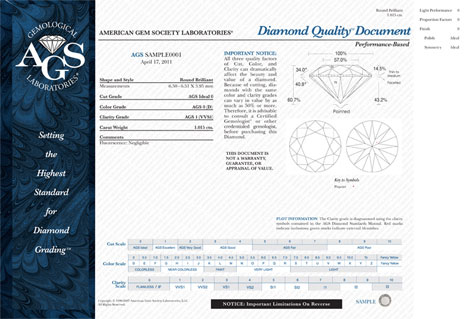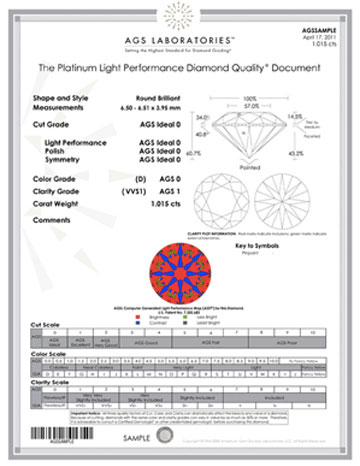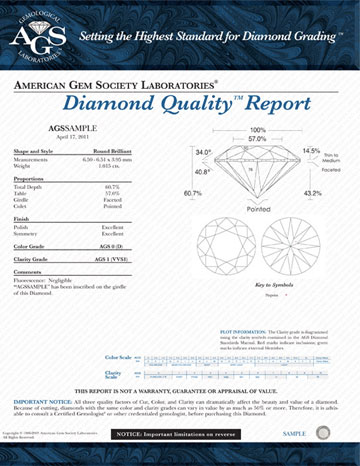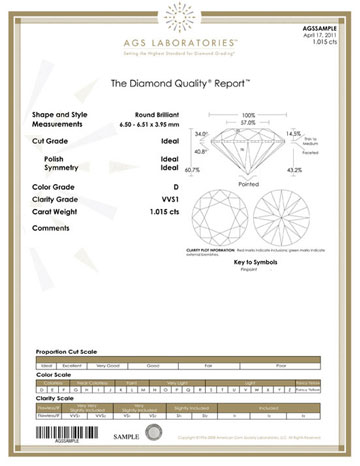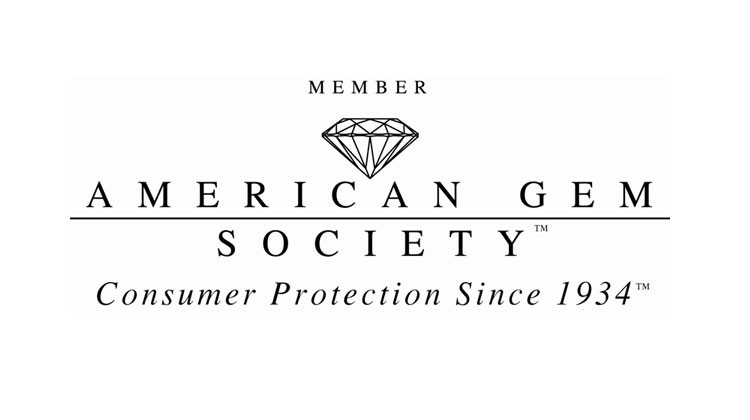
The AGS is a jewellery association that was established in 1934 as a non-profit organization. Once every two years, the board of directors elects a President to lead the society. The board delegates the day-to-day running of the AGS to Executive Director and CEO, Ruth Batson, who is currently the CEO of both the AGS and the AGS Laboratories (AGSL).
The AGSL was founded in 1996 and was originally a for-profit business that was majority owned by the AGS with the rest being owned by its members, also known as titleholders. In 2012, the AGS purchased the AGSL back from its titleholders so currently the AGSL is a wholly owned subsidiary of the AGS.
Both the AGS and the AGSL stress that their primary mission is consumer protection. All titleholders are called to uphold the code of ethics set by the AGS, which includes the full disclosure of facts about the products they sell and proper resolution of any customer complaint.
AGS titleholders are vetted for good financial stability so consumers can be assured that they are dealing with a reputable business when they work with a titleholder. AGS titleholders or their employees must also have the requisite credentials set by the AGS. All applications to become a titleholder are peer reviewed and there is an annual recertification exam.
The AGS also makes an effort to standardize the way the diamond industry communicates about diamond beauty. For example, the AGS defines a single event of white light return as ‘a flash of light’ and a single event of colored light return as ‘fire’. Scintillation is also separated into flash-scintillation and fire-scintillation. Once the industry starts using a common language, consumers will have a more consistent environment to do their shopping.
The development of the Angular Spectrum Evaluation Tool (ASET) by the AGS is another important contribution to the diamond industry. The ASET allows an observer to visualize intense light return as ‘red’, weak light return as ‘green’, light leakage as ‘white’, and contrast as ‘blue’. This has made it much easier for consumers to understand diamond light performance.
GIA vs AGS
I’m often asked what the difference is between GIA and the AGS. In my opinion, the biggest difference between the two labs is in scale.
We can compare the two labs based on their 2012 revenues that are publicly available. According to guidestar.org, GIA had revenues of $180.3 million and AGS had revenues of $6.8 million in the same period. If we assume that a large part of the revenue for both labs is from grading diamonds, we can deduce that many more diamonds flow through GIA than AGSL.
Given that there are still many other labs that grade diamonds, a rough estimate is that less than 2% of all diamonds will come with AGS certification. This means that a diamond that comes with AGS certification is actually more rare than a D-color diamond!
Being much larger in scale, GIA has a lot more influence than AGS in the diamond industry. It’s not hard to imagine then that GIA graders are under much more financial pressure. This has in the past led to misconduct such as the over-grading of diamonds.
For me, this means that there is a smaller chance of an AGSL certified diamond being over-graded. On top of this, even if we assume that the same percentage of diamonds are being over-graded at both labs, it would still mean that there are many more GIA diamonds in the market that are over-graded.
The problem is that this makes it easier for unscrupulous vendors to specialize in these over-graded GIA diamonds. Although this may still happen with AGSL certified diamonds, the chances of it happening is much smaller.
AGS Diamond Grading
The AGS uses different terminology to the GIA for grading the 4Cs. The AGS created a 0-10 system and the rationale is that numbers are easier for consumers to understand. However, I find that the AGS system can actually be more confusing at times. For example, the AGS system goes up in intervals of 0.5 for color, but for cut and clarity it goes up in intervals of 1. This means a VVS1 is an AGS1, but an E-color is an AGS0.5.
Also confusing is that the AGS groups both Flawless and Internally Flawless grades under the AGS0 grade. The AGS also decided to group together the colors X, Y, and Z into a single AGS10 grade. It seems like AGS adopted the 0-10 system just to be different and this seems to go against what they’ve been doing to create a common language in the industry.
In practice, the difference between an AGS grade and the equivalent GIA grade for color and clarity is in name only because the AGSL follows the GIA approach. Every AGS grader must have the same credentials as those required of GIA graders and both labs will have at least two graders analyze each factor.
The main difference in grading between GIA and the AGSL is that the AGSL follows the standards set by the AGS for grading cut. The AGS uses a light performance-based system in their Diamond Quality Document (DQD), whereas GIA uses a proportions-based system in their Diamond Grading Reports. Also, the AGSL issues a cut grade for fancy shaped diamonds such as princess, emerald, cushion, and oval cuts, but GIA does not. On the flip side, GIA issues certificates for fancy color diamonds and AGSL does not.
DQD
The DQD is AGSL’s bread and butter report and is similar to GIA’s Diamond Grading Report. Even though the AGS uses the 0-10 system, there is a conversion table provided at the bottom of the report so that you can easily reference the GIA terminology.
If you are familiar with a GIA lab report, you will notice that one of the differences in the AGSL report is that there are no separate headings for polish, symmetry, and fluorescence. Fluorescence is also shown in the comments section of the report along with whether there are any treatments or laser inscription.
Polish and symmetry are combined into an overall cut grade, which can only be as high as each individual cut parameter. For example, a diamond with AGS0 in proportions but AGS1 in symmetry will receive an overall cut grade of AGS1. The cut grade that is assigned in this report is AGS’s light performance-based cut grade.
Platinum DQD
The Platinum DQD has all of the information in the standard DQD with the addition of a computer-generated ASET image. This image is part of a 3D-model of the diamond, created using digital scanners, required as part of the grading process. Although the image on a report only shows the face-up view, the actual cut-grade is based on light-tracing software modelling the light return from many different angles. The Platinum DQD also has separate headings for polish and symmetry so that you can see the individual grades.
The Platinum DQD is also available in a proprietary format that is customizable by a vendor. For example you can add logos and other branding to the report and even also include a hearts image. A customized report will have a title that states that it is a Proprietary Diamond Quality Document.
Vendors specializing in top of the line H&A diamonds will find this useful to set themselves apart from other high-end vendors. I have to say that a Proprietary DQD with a hearts image is my favorite type of diamond certificate because everything that you need to evaluate a diamond is in one single place.
What you’ll find is that due to the pricing and design of these reports, only diamonds with AGS0 in cut will be sent to get a DQD or Platinum DQD. The result is that the DQD is now associated with AGS ideal-cut diamonds and this makes it easier for consumers to identify well-cut diamonds provided that they know what the difference is between a DQD and a DQR.
Diamond Quality Report (DQR)
The DQR was created for diamonds that are less than ideal. I’m not a big fan of this report as it essentially hides the proportions cut grade from the consumer. I can understand the appeal from a vendor’s point of view because a diamond that shows a poor proportions cut grade is less marketable. However, this again seems to goes against AGSL’s mission of consumer protection.
In my opinion, it would be far better for this report to show the breakdown in cut grade than to simply show the symmetry and polish grades. For round brilliants, you will not find any GIA reports that hide the cut grade. However, for fancy shapes, this report may actually be better than a GIA report as you will receive more information regarding the crown and pavilion angles.
Gold DQR
The Gold DQR is my least favorite report. This is a DQR but an overall cut grade is given on this report. However, the confusing part is that this is a 2D proportions-based cut grade instead of a 3D light performance-based cut grade. In the report itself, the only mention that the cut grade is a proportions-based one is in the scale given at the bottom of the report.
I think this is potentially a dangerous report for the average consumer because it opens up the possibility of a vendor marketing a diamond as an ‘AGS ideal’ in cut, which it states very clearly on the report, and then have the consumer believe that what they purchased is an AGS0 ideal-cut diamond.
The only justification for this report seems to be that in essence it is the AGSL equivalent to the GIA Diamond Grading Report. However, GIA doesn’t utilize two different cut-grading systems so their reports are not confusing at all. Adding to the confusion, the AGSL Gold DQR and the new GIA Diamond Grading Reports are the same color. The Gold DQR was created to allow some flexibility for the trade, but in the interest of consumer protection, my opinion is that the AGSL should get rid of the DQR and Gold DQR.
Other Types of AGSL Reports
Apart from the reports I mentioned above, the AGSL offers several other reports such as the Diamond Quality Analysis (DQA), Diamond Quality Certificate (DQC), Diamond Consultation, and Scintillation Report (for Ritani diamonds only). These are not as common so I don’t want to spend too much time on them.
I do however want to point out that a DQA doesn’t have a clarity plot and is therefore similar to a GIA Diamond Dossier. Just like the Dossier, the DQA also includes laser inscription and you can expect smaller diamonds graded by AGSL to come with a DQA.
Why buy a diamond with AGSL certification?
Most of you already know that getting a certified diamond from a respected lab is a necessary part of buying a diamond. But are there any reasons why you would buy an AGSL certified diamond? Well I’ve covered most of these points already, but I will summarize them again.
On average, AGSL certified diamonds are cut better than GIA certified diamonds. This isn’t because AGSL is stricter lab than GIA, but it is rather just a reflection of the fact that more diamonds are sent to GIA and only very well-cut diamonds can find added value with AGSL.
Therefore given a random GIA Triple Ex and a random AGS0 in a blind purchase, I would always choose the AGS0. For round brilliants though, if I have sufficient information in front of me to determine how well a diamond will perform then it is unnecessary to get AGS certification.
For fancy shape diamonds, AGS0s are a much safer bet compared to GIA Ex/Ex’s. Unfortunately, the vast majority of fancy shape diamonds are poorly cut and will most likely be sent to GIA for grading. This also means that fancy shape diamonds that are AGS0 in cut are not easy to find.
One exception is the princess cut, which is gaining in popularity and there are niche vendors who are making the push to bring more AGS0 princess cuts to the market. If you’re in the market for a princess cut, then I strongly recommend that you get an AGS0 princess cut even though it may be at a significant premium.
Another reason why you might buy an AGSL certified diamond is if you’re looking for a super ideal-cut H&A diamond. Many vendors who specialize in these top of the line diamonds will send them to the AGSL for certification. This is because these diamonds can take advantage of a report that highlights light performance and optical symmetry. For these vendors, sending a diamond to AGSL for certification has the additional benefit of having much faster turn-around times.
Conclusion
AGSL has a reputation to be the go to lab for the best cut diamonds in the world, and as you can see, there are many good reasons why you might want to look for a diamond with AGSL certification. One final thing you should bear in mind is that although AGS’s reputation is growing, GIA is still much more well-known in most parts of the world.
I think it’s safe to say that if you live in the United States, then getting a diamond with AGSL certification will not be any worse than GIA certification. However, outside of the United States, many people have never heard of the AGSL and this means that a GIA diamond will have more liquidity in case you ever want to resell your diamond.
If you need help finding or evaluating an AGSL certified diamond, then please feel free to contact me.
